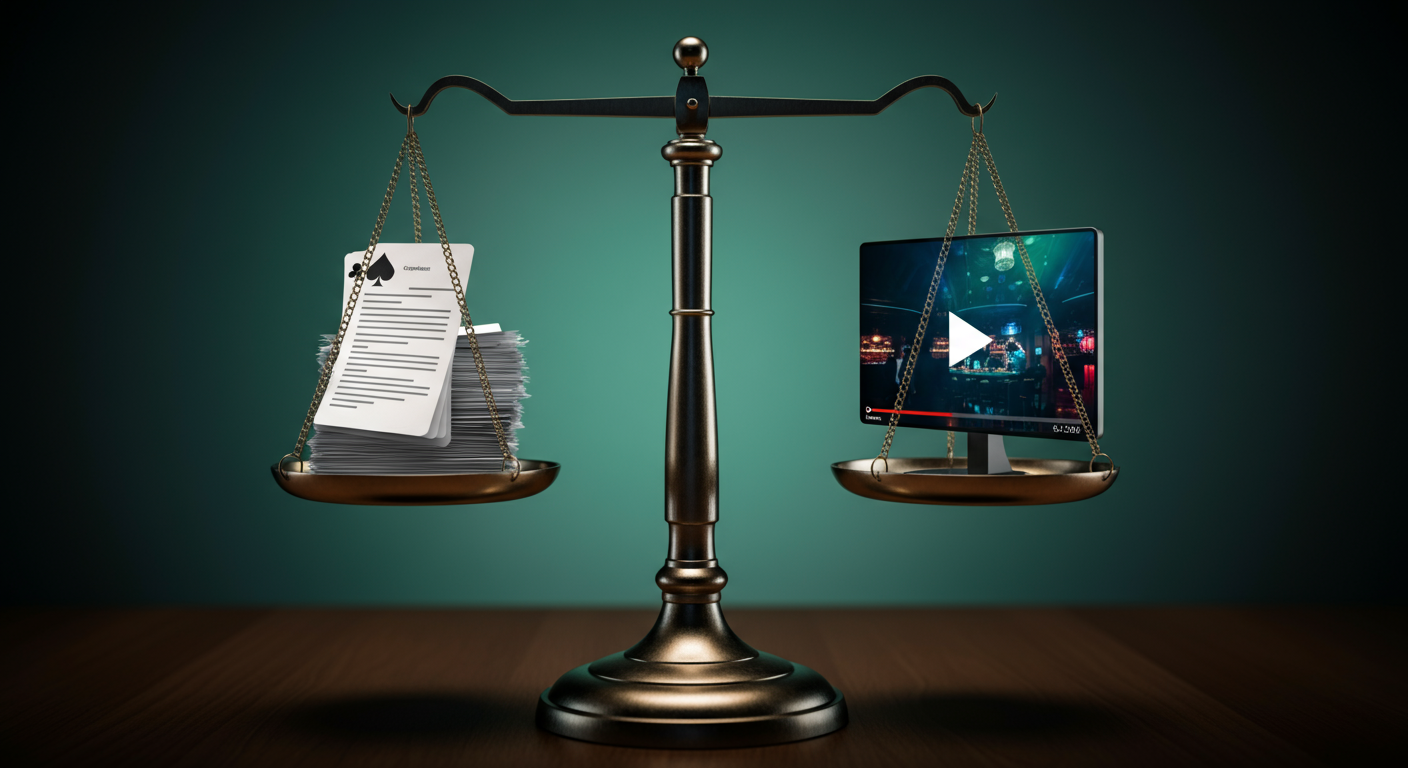In an era where captivating content reigns supreme, businesses in the hospitality and entertainment sectors face a unique challenge: delivering engaging commercial video programming while navigating a complex legal landscape. Understanding the legal intricacies of video programming is crucial for businesses like casinos, restaurants, and bars aiming to enhance customer experiences. This Commercial Video Programming Legal Guide serves as an invaluable resource, helping you stay compliant while entertaining your clientele.
With the increasing demand for tailored entertainment solutions, multi-location organizations and businesses seeking centralized systems must be acutely aware of the legal requirements surrounding commercial video programming. Failure to comply can lead to costly penalties and reputational damage. As industry leaders in delivering high-quality content, DLM Media is committed to providing businesses with the knowledge and tools needed to navigate these challenges effectively.
This comprehensive guide will delve into the essential aspects of commercial video programming law, offering clear insights and practical advice. We’ll cover topics such as licensing requirements, copyright considerations, and best practices for compliance. By staying informed and proactive, you can ensure your business not only meets legal standards but also thrives in a competitive market.
Embark on this journey with us as we explore the legal facets of commercial video programming, equipping your business with the expertise to create a seamless and enjoyable viewing experience for your customers. Together, let’s unravel the complexities and unlock the potential of commercial video programming for your business. Ready to begin? Let’s dive into the world of legal compliance and strategic entertainment solutions.
Understanding Copyright and Licensing in Video Programming
In the realm of commercial video programming, understanding copyright and licensing is crucial to avoid legal pitfalls. These legal frameworks ensure that creators’ rights are respected while allowing businesses to use content effectively. Navigating these laws can be complex, but with the right knowledge, businesses can thrive without infringing on intellectual property rights.
Copyright law grants creators exclusive rights to their works, including video content. This means businesses must secure appropriate licenses to use copyrighted material legally. Failure to do so can result in significant legal repercussions, including fines and lawsuits. Therefore, understanding the types of licenses required and how to obtain them is essential for any business involved in video programming.
Fair Use and Its Limitations
Fair use is a legal doctrine that allows limited use of copyrighted material without permission from the rights holder. It applies in specific circumstances, such as criticism, comment, news reporting, teaching, scholarship, or research. However, determining fair use can be subjective and depends on factors like the purpose of use, the nature of the copyrighted work, the amount used, and the effect on the market value of the original work.
For instance, using a short clip from a movie in a news segment might qualify as fair use, but using the same clip in a commercial advertisement likely would not. Businesses must carefully evaluate each use case to determine if it falls under fair use or requires licensing.
Types of Licenses Needed
Various licenses are necessary for different types of video programming. A synchronization license, for example, is required when using music in conjunction with video content. This license is obtained from the music publisher. Additionally, a master use license is needed to use a specific recording of a song, which is obtained from the record label.
Businesses must also consider internet licenses if they plan to distribute content online. Each type of license serves a specific purpose, and obtaining the correct ones is crucial to ensure compliance with copyright laws.
Common Licensing Issues and Resolutions
One common issue businesses face is the unauthorized use of copyrighted material, often due to a misunderstanding of licensing requirements. This can lead to legal disputes and financial penalties. To avoid such issues, businesses should conduct thorough research and consult legal experts when necessary.
Case studies illustrate how companies have successfully navigated licensing challenges. For example, a restaurant chain that wanted to use popular music in its promotional videos worked closely with a legal team to secure the necessary synchronization and master use licenses. This proactive approach not only ensured compliance but also enhanced the brand’s image by associating it with well-known music.
By understanding and adhering to copyright and licensing laws, businesses can effectively use video programming to enhance customer experiences while minimizing legal risks. For more insights on navigating the legal landscape of commercial video programming, explore additional resources on DLM Media’s website.
Legal Considerations for Filming and Production
In the world of commercial video programming, understanding the legal requirements for filming and production is essential. Whether you’re producing content for casinos, restaurants, or bars, adhering to legal standards can prevent costly disputes and ensure a smooth production process. This section of the Commercial Video Programming Legal Guide will explore the critical elements of legal compliance during filming and production, including the importance of release forms, location permits, and production insurance.
Filming and production in commercial settings involve multiple legal considerations, each crucial to protecting your business and its creative output. From securing the right permissions to ensuring the safety of your crew and talent, these steps form the backbone of a legally sound production strategy.
Importance of Release Forms
Release forms are indispensable in video production, granting you the right to use footage of individuals and locations. These documents protect your business from potential legal claims by ensuring that all parties involved have consented to the use of their likeness or property. For instance, a restaurant filming a commercial must obtain model releases from all identifiable individuals appearing in the footage.
Without proper release forms, businesses risk facing lawsuits for invasion of privacy or unauthorized use of likenesses. A notable case involved a production company that failed to secure releases for extras in a commercial, resulting in a costly settlement. To avoid such pitfalls, always ensure that release forms are signed before filming begins.
Securing Location Permits
Filming on location often requires permits, especially in public or high-traffic areas. These permits grant you legal permission to shoot in specific locations and help manage logistical challenges like crowd control and traffic management. For example, a bar producing a promotional video in a bustling city center must secure the necessary permits to avoid fines or disruptions.
Obtaining location permits can be a complex process, involving negotiations with local authorities and compliance with zoning laws. However, the effort is worthwhile, as filming without the proper permits can lead to production delays and legal complications. A well-known case involved a production team that ignored permit requirements, resulting in a shutdown by local authorities and significant financial losses.
Production Insurance Essentials
Production insurance is another critical component of legal compliance in video production. It protects your business from unforeseen incidents, such as accidents on set or equipment damage. General liability insurance, for instance, covers injuries to cast or crew members, while equipment insurance safeguards against loss or damage to expensive gear.
Consider the case of a casino filming a commercial that experienced a lighting rig collapse, injuring several crew members. Without adequate insurance, the casino faced substantial medical and legal expenses. By investing in comprehensive production insurance, businesses can mitigate such risks and ensure a smoother production process.
In conclusion, understanding and adhering to the legal considerations for filming and production is vital for any business involved in commercial video programming. By prioritizing release forms, location permits, and production insurance, you can protect your business and create high-quality content without legal hindrances. For more insights into navigating the legal landscape of commercial video programming, explore additional resources on DLM Media’s website.
Ensuring Compliance with Advertising Regulations
In the dynamic world of commercial video programming, staying compliant with advertising regulations is crucial. Businesses, especially those in the hospitality and entertainment sectors, must navigate a complex web of rules to avoid potential penalties. Understanding these regulations not only safeguards your business but also enhances your brand’s credibility and trustworthiness.
Advertising regulations are designed to ensure that all promotional content is truthful, non-deceptive, and fair. Regulatory bodies like the Federal Trade Commission (FTC) in the United States play a significant role in enforcing these standards. They scrutinize advertisements to protect consumers from misleading claims and ensure a level playing field for businesses.
The Role of Regulatory Bodies
Regulatory bodies are the gatekeepers of advertising integrity. The FTC, for example, monitors advertising practices to prevent false or misleading claims. They require advertisers to substantiate their claims with reliable evidence. This means that any statement made in an advertisement must be backed by factual data.
For businesses involved in video programming, understanding the guidelines set by these bodies is essential. Non-compliance can lead to severe penalties, including fines and legal action. Therefore, it is crucial to stay updated on the latest regulations and ensure that all advertising content aligns with these standards.
Adhering to Advertising Guidelines
Adhering to advertising guidelines involves a thorough understanding of what constitutes compliant and non-compliant advertising. Compliant advertisements are transparent, do not exaggerate product capabilities, and avoid making unsubstantiated claims. For instance, a video ad promoting a restaurant’s new menu should accurately represent the dishes without embellishing their benefits.
On the other hand, non-compliant advertising might involve exaggerated claims about a product’s effectiveness or benefits without proper evidence. Such practices can mislead consumers and result in regulatory scrutiny. Businesses must ensure that their advertising teams are well-versed in these guidelines to avoid potential pitfalls.
Examples of Compliant and Non-Compliant Advertising
Consider a scenario where a bar advertises its new cocktail as the “best in the city.” To comply with advertising regulations, the bar must provide evidence supporting this claim, such as awards or customer testimonials. Without such evidence, the claim could be deemed misleading.
Conversely, a compliant advertisement might state that the bar’s cocktail is “popular among customers,” backed by customer reviews or survey data. This approach not only aligns with regulatory standards but also builds consumer trust by providing transparent and verifiable information.
For more insights on navigating the legal landscape of commercial video programming, explore additional resources on DLM Media’s website.
Key Takeaways for Legal Compliance in Video Programming
In the rapidly evolving landscape of commercial video programming, staying ahead of legal requirements is not just a necessity but a strategic advantage. Throughout this Commercial Video Programming Legal Guide, we’ve explored the critical aspects businesses must consider to ensure compliance and protect their interests. By understanding copyright, licensing, and advertising regulations, your business can avoid costly legal pitfalls while delivering exceptional entertainment experiences to your customers.
Here are some essential takeaways to keep in mind:
- Comprehensive Licensing: Ensure you have the appropriate licenses for all video content, including synchronization and master use licenses for music. This prevents infringement and protects your business from legal action.
- Release Forms and Permits: Always secure release forms from individuals featured in your productions, and obtain necessary location permits to avoid legal disputes and production delays.
- Adherence to Advertising Standards: Familiarize yourself with advertising regulations to ensure all promotional content is truthful and non-deceptive, thereby maintaining your brand’s credibility.
- Production Insurance: Invest in comprehensive production insurance to safeguard against unforeseen incidents, protecting both your business and your creative output.
These steps are crucial in ensuring your business remains compliant while enhancing the customer experience. However, legal landscapes can be complex and ever-changing, making it wise to consult with legal professionals for tailored advice.
As you continue to navigate the world of commercial video programming, we invite you to explore more resources on DLM Media’s website. Our commitment to providing worry-free, high-quality entertainment solutions ensures that your business can thrive in a competitive market.
Have questions or need further guidance? Feel free to reach out to our team of experts, who are ready to assist you on your journey to achieving seamless legal compliance in commercial video programming.





